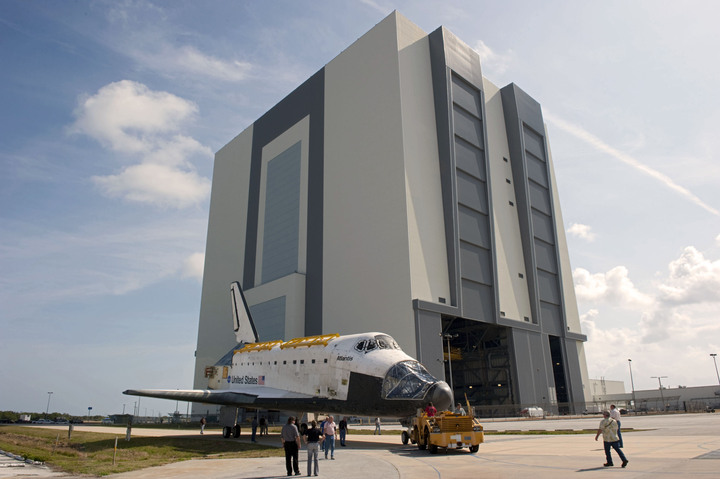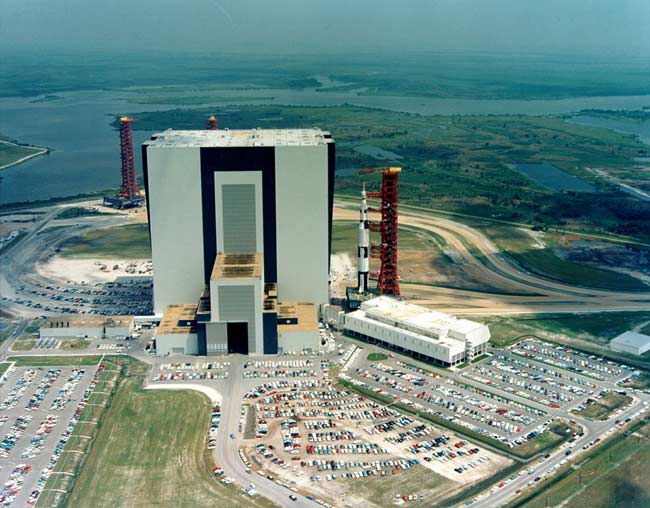NASA's Kennedy Space Center (KSC) Information
NASA's Kennedy Space Center in Florida has long served as America's spaceport, hosting all of the federal government's manned spaceflights since the late 1960s.
KSC is named after President John F. Kennedy, who famously declared in 1961 that the United States would put an astronaut on the moon, and bring that person safely back to Earth, before the end of the decade.
KSC was pivotal to that bold effort, which ultimately succeeded when Neil Armstrong and his two Apollo 11 crewmates splashed down in the Pacific Ocean on July 24, 1969. Apollo 11 launched from KSC, as did all subsequent flights in the Apollo program, and every one of the space shuttle's 135 missions.
But the end of the shuttle program in July 2011 brought big changes to the Florida center, which has seen its workforce fall to 8,500 employees from 15,000 about 15 years earlier. Here are some basic facts about KSC, its storied past and where the center is headed in the future. [The Space Shuttle Program in Pictures]
Cape Canaveral's neighbor
KSC spreads across 219 square miles (567 square kilometers) on Merritt Island, just northwest of Florida's Cape Canaveral.
The cape has been a center of U.S. launch activity since 1949, when President Harry Truman established the Joint Long-Range Proving Ground — currently known as the Eastern Range or "the Range" — there to test missiles.
It was a nearly ideal location for this purpose — virtually uninhabited, with a climate permitting year-round activities. And vehicles could be launched out over the Atlantic Ocean, minimizing the chances of affecting populated areas. By January 1960, the range extended 5,000 miles and included 13 major stations, about 91 outlying sites, a fleet of ships and three marine support stations.
Breaking space news, the latest updates on rocket launches, skywatching events and more!
The first launch from the cape occurred in 1950, when a military-civilian team lofted a modified German V-2 rocket to an altitude of 10 miles (16 km). On Jan. 31, 1958, Explorer 1 blasted off from Cape Canaveral, becoming the United States' first satellite to reach orbit.
In 1961, NASA and the Department of Defense signed an agreement to establish funding practices on the range. The young space agency was already utilizing old Air Force and Army launch sites for its Mercury Program, with three major launch complexes of its own under construction. The agreement divided the ownership of the launch area, with the Merritt Island Launch Area going to NASA while the Air Force retained control of Cape Canaveral.
KSC's early years
NASA became operational in October 1958. Just three years later, the space agency began gearing up to put a man on the moon, directed by the goals President Kennedy outlined in a speech to Congress on May 25, 1961.
Such an ambitious undertaking would require the biggest rocket ever built — the 363-foot-tall (111 meters) Saturn 5. The facilities at Cape Canaveral couldn't support such an enormous vehicle, according to NASA records, so space agency officials began looking for another site. [Lunar Legacy: Apollo Moon Mission Photos]
They settled on nearby Merritt Island, and began acquiring land there in 1962. The new facility was originally called the Launch Operations Directorate (LOD), and it reported to NASA's Marshall Space Flight Center in Alabama.
In July 1962, the LOD was renamed the Launch Operations Center and put on equal footing with other NASA centers. It received its current name on Nov. 29, 1963, just one week after President Kennedy was assassinated in Dallas.
In 1963, construction began on the Apollo-Saturn facilities, some of which are truly monumental. KSC's Vehicle Assembly Building, for example, measures 525 feet tall by 716 feet long by 518 feet wide (160 by 218 by 158 m). The VAB, which was completed in the mid-1960s, remains one of the largest buildings in the world.
Launch elements of NASA's Manned Spacecraft Center in Houston — now known as Johnson Space Center — were transferred to KSC in December 1964.
"All of the centers play a critical role in NASA's success, but nowhere else does it come together like it does here at Kennedy," said Kennedy Director Robert Cabana at the center's 50th anniversary celebration. "This team has seen a lot in the last 50 years and we've contributed to great successes at NASA."
Apollo and the space shuttle
Neil Armstrong, Buzz Aldrin and Michael Collins blasted off for the moon from KSC on July 16, 1969. Other moonwalkers followed in their footsteps, until the last Apollo flight in December 1972.
"Throughout those 50 years, there's been one common theme, and that's an insatiable desire to explore, to send humans and robotic spacecraft beyond the confines of our home planet, in a never-ending quest to expand our knowledge of the universe," Cabana said.
After 1975's manned Apollo-Soyuz Test Project — the first joint U.S.-Soviet spaceflight — NASA began modifying KSC to accommodate the space shuttle, which would make its maiden space voyage in April 1981.
The shuttle served as America's human spaceflight workhorse for the next 30 years, and KSC was the vehicle's home base. Five different orbiters blasted off on a total of 135 space missions from KSC, and most flights landed there, too. (Some touched down at Edwards Air Force Base in California, and one mission landed at New Mexico's White Sands Space Harbor.)
Tragically, only three space-flown shuttles would survive through the program's end in July 2011. Challenger exploded shortly after liftoff in January 1986, and Columbia broke apart upon re-entry in February 2003. Each accident claimed the lives of all seven astronauts onboard.
Transition period
The remaining shuttles — Discovery, Endeavour, Atlantis and the prototype Enterprise, which never reached orbit — are now museum pieces as NASA enters a new period in its human spaceflight history. [Infographic: Where to See America's Greatest Spaceships]
The space agency is grooming private American firms to ferry astronauts to and from Earth orbit. Meanwhile, NASA is focusing on getting people to a near-Earth asteroid by 2025 and then on to Mars by the mid-2030s.
The end of the shuttle program hit the KSC workforce hard, resulting in the loss of many jobs. But officials are positioning KSC to remain at the forefront of American manned spaceflight activities. [Infographic: NASA Centers' New Mission]
For example, XCOR Aerospace will manufacture its two-person Lynx spacecraft at KSC, and the suborbital rocketplane will launch from the site as well. KSC will also likely serve as home base for Sierra Nevada's Dream Chaser space plane and ATK's Liberty Launch system, two vehicles vying to take over the space shuttle's astronaut-taxi role.
And NASA's Space Launch System — the massive new rocket that will blast American crews toward deep space destinations — will take off from KSC as well. The first test flight of the SLS is slated for 2019, and NASA hopes the rocket and its Orion capsule are flying astronauts by 2021, though changes may continue to push that date back.
Further, KSC remains a node of unmanned spaceflight activity. The center manages three pads at Cape Canaveral Air Force Station that have sent off many Earth-observing satellites and interplanetary probes over the years.
NASA's $1.1 billion Jupiter-bound Juno probe launched from the cape in August 2011, for example, as did the $2.5 billion Curiosity Mars rover less than four months later. In August 2012, the Radiation Belt Storm Probe mission took off from Cape Canaveral, lofting two armored spacecraft into Earth's Van Allen radiation belts. NASA's OSIRIS-REx sample return mission to an asteroid launched in September 2016. A number of SpaceX rockets also launch from KSC.
The visitor complex
Recently, the Kennedy Space Center Visitor Complex has welcomed about 1.5 million visitors every year. The Visitor Complex offers a range of exhibits and films, as well as tours of KSC. It's found on federal land, near operating KSC facilities; the address is SR 405, Kennedy Space Center, FL 32899.
In 2013, the space shuttle Atlantis was put on display at the Visitor Complex. Atlantis flew the shuttle program's last-ever mission, touching down for good on July 21, 2011.
Additional reporting by Nola Taylor Redd, Space.com contributor.
Additional resources

Michael Wall is a Senior Space Writer with Space.com and joined the team in 2010. He primarily covers exoplanets, spaceflight and military space, but has been known to dabble in the space art beat. His book about the search for alien life, "Out There," was published on Nov. 13, 2018. Before becoming a science writer, Michael worked as a herpetologist and wildlife biologist. He has a Ph.D. in evolutionary biology from the University of Sydney, Australia, a bachelor's degree from the University of Arizona, and a graduate certificate in science writing from the University of California, Santa Cruz. To find out what his latest project is, you can follow Michael on Twitter.


